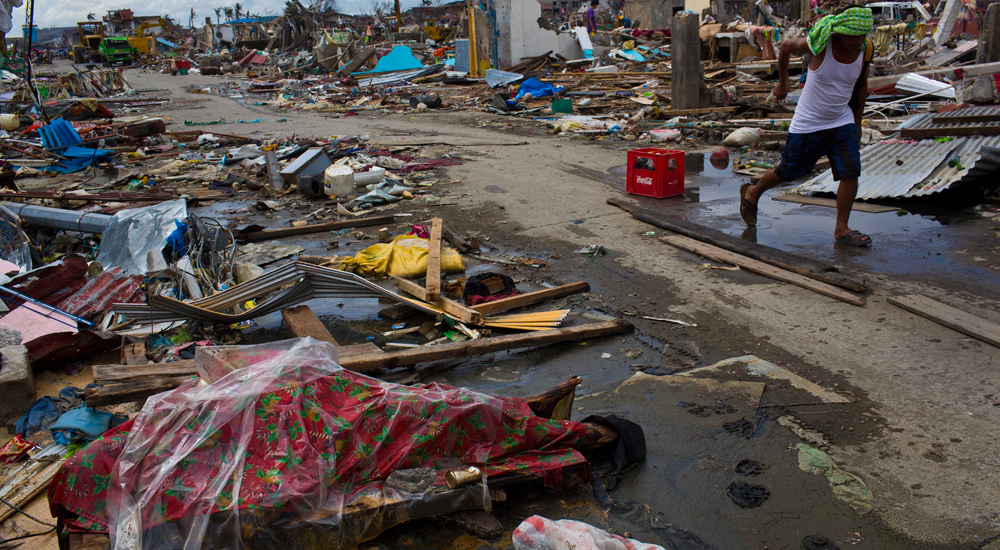Search for missing a hellish daily task

A Typhoon Haiyan survivor walks past a dead body, wrapped in plastic Christmas theme wrapping in Tacloban on Saturday, Nov. 16, 2013. For those still looking for loved ones missing since the Nov. 8 storm, their already torn-apart lives are shot through with a difficult question—How do you move on when there is no body to bury? AP PHOTO/DAVID GUTTENFELDER
TACLOBAN CITY, Philippines—John Lajara peers under a slab of crumbled concrete, lifts a sodden white teddy bear then drops it back into the filth. He reaches again into the rubble and pulls out a boot, a treasured find in this typhoon-flattened village.
But he’s searching for something far more precious—the body of his brother, Winston.
For those still looking for loved ones missing since last week’s storm, their already torn-apart lives are shot through with a difficult question—How do you move on when there is no body to bury?
The search for the missing—1,179 by official count—has become a hellish daily activity for some.
In Lajara’s seaside village, residents estimate about 50 of the 400 people who lived there were killed. About half of the dead were still missing: mothers, fathers, children and friends.
No answers
“Somehow, part of me is gone,” Lajara said as another fruitless expedition in the rubble ended on Saturday.
Lajara has carried out the routine since both he and his brother were swept from their house by Supertyphoon “Yolanda.” And every day has ended so far with no answers on Winston’s fate.
Many of the bodies remain tangled in debris, or are lining the road in body bags that seep fetid liquid. Some are believed to have been swept out to sea.
After the initial days of chaos, when no aid reached the more than 600,000 people rendered homeless, an international aid effort gathered steam.
“We’re starting to see the turning of the corner,” said John Ging, a top UN humanitarian official in New York.
The focus of the aid effort is on providing life-saving aid for those who survived, while the search for missing people is lower in the government’s priorities.
Dante and Charana
Lajara’s neighbor Neil Engracial cannot find his mother or nephew, but he has found many other bodies. He pointed at a bloated corpse lying face down in the muddy debris.
“Dante Cababa—he’s my best friend,” Engracial said. He pointed to another corpse rotting in the sun. “My cousin Charana.” She was a student, just 22.
Lajara remembers the moment his brother vanished.
They were standing side by side with relatives and friends before the surge hit. They stared at the rising sea, then turned to survey the neighborhood behind them, trying to figure out where they could run. Then the wave rushed in.
Lajara, Winston and the others dived into the water and were swept away from each other. He never saw Winston again.
Lajara has trudged through the corpse-strewn piles of rubble and mud, searching for two things: wood to rebuild his home, and Winston.
He found only wood.
On Saturday, he set out again. The rat-a-tat-tat of a snare drum echoed across the landscape as a young boy played the instrument from the roof of a gutted building.
It was a grim accompaniment to what had become Lajara’s daily march into the corpse-strewn wasteland that was his home.
Not in the library
Reminders of the people who once lived here are wedged everywhere among the piles of wood, glass and mud: a smiling, bowtie-clad stuffed bumblebee. A woman’s white platform shoe. A wood-framed photograph of a young boy.
Suddenly, a neighbor, Pokong Magdue, approached.
“Have you seen Winston?”
Magdue replied: “We saw him in the library.”
Lajara shook his head. It couldn’t be Winston. He had already searched the library.
Conflicting emotions
Sometimes people came to him, saying Winston’s body had been found. Lajara must walk to the corpse, steel himself and roll it over to examine the face.
He then must deal with conflicting emotions: relief that the body was not his brother’s and hope that Winston might still be alive.
And grief that he still had no body to bury. Because at least then, he said, he could stop searching.
Winston was his only brother. He had a wife and two children. He was a joker who made everyone laugh. He drove a van for a living and was generous to everyone. He was a loving father.
“It’s hard to lose somebody like him,” Lajara said.
Only trace
Now, the only trace of his brother that remains is his driver’s license: Winston Dave Argate, born Dec. 13, 1971. 177 centimeters tall, 56 kilograms.
The upper left-hand corner of the license is gone, and the picture is faded.
He gazed at the card in his hand. “When I want to see him, I just stare at his picture.”